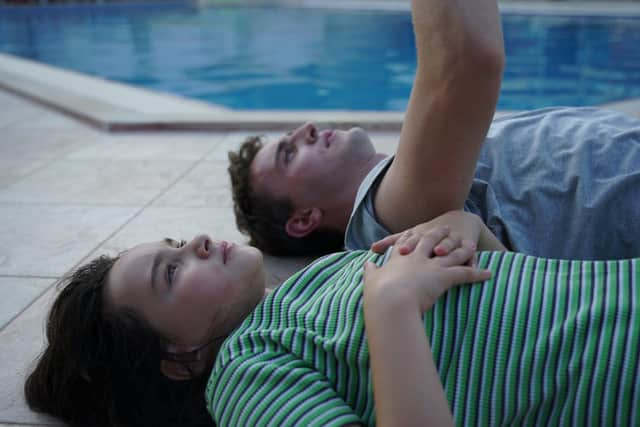Arts review of 2022: Alistair Harkness on the year in film
Aftersun In a year that saw the demise of the Edinburgh International Film Festival, the Filmhouse and Aberdeen’s Belmont in one fell swoop, this blistering debut from Edinburgh-raised filmmaker Charlotte Wells felt like a soothing balm — an artistically daring effort that hit big with audiences and proved there was still an appetite for passionate, personal, risk-taking cinema. That the now New York-based Wells got her first introduction to world cinema by having the EIFF and Filmhouse on her doorstep growing up is an irony that shouldn’t be forgotten, especially as Aftersun — which opened this year’s EIFF — continues its successful box-office run and heads into the awards season as the indie upstart to beat. But the film of the year was also a technically dazzling and emotionally devastating meditation on memory and loss. And in young Scottish actress Frankie Corio — also making her debut as the film’s lead, opposite Paul Mescal — it showcased the emergence of a talent in front of the camera every bit as exciting as Wells’ arrival behind it.
Top Gun: Maverick Delayed for two summers and already more than three-decades on from the ridiculous, corny, Reaganite original, Tom Cruise’s return to the film that made him a megastar was the most joyously entertaining blockbuster event of the year (sorry Avatar). Cruise’s commitment to delivering big screen thrills was infectious, and it reaffirmed the power a proper movie star has to transport us to another world. In the wake of the pandemic it was the movie that beleaguered multiplexes and audiences desperately needed. Thanks to Cruise, it didn’t disappoint.
Advertisement
Hide AdEverything Everywhere All At Once The break-out film of the year was a wild, inter-dimensional martial arts fantasy that took the suddenly in vogue concept of the multiverse (see also Sam Raimi’s entertainingly bonkers Doctor Strange and the Multiverse of Madness) and used it to drag Michelle Yeoh through infinite versions of her character’s life as she tried to figure out how to fix her dysfunctional family. Directed by music video upstarts Daniel Kwan and Daniel Scheinert (collectively known as Daniels), their frenzied style was exhilarating to watch – and oddly apropos for our chaotic social media age.


Nope From the multiverse to the what-the-f***-averse, Jordan Peele’s latest blended together several genres into a brilliantly realised Twilight Zone-style sci-fi film set on the fringes of the movie industry. That setting wasn’t random either. Nope took us on an electrifying cinematic ride that pulled the curtain back on the cost such rides sometimes entail, with Peele’s camera-inspired alien threat drawing attention to the power movies have to capture or erase history depending on who’s in charge of the medium. Mainstream cinema doesn’t come much smarter.
Licorice Pizza Paul Thomas Anderson’s coming-of-age drama was also set on the edge of the entertainment industry, albeit in LA circa 1973. A freewheeling meditation on first love, obsession and the hucksterism of adolescence, it featured great performances from Cooper Hoffman (son of Philip Seymour Hoffman) and pop star Alanah Haim, both playing characters negotiating that precarious moment in a young person’s life when who you’re going to be really starts taking root. That was also the theme of James Gray’s wise and wonderful Armageddon Time. But did Armageddon Time feature a magnificently odious Bradley Cooper as future movie producer Jon Peters? It did not.
The Souvenir Part II The second part of Joanna Hogg’s cinematic roman à clef – fictionalising her early years as a filmmaker in 1980s London – was another inventive piece of auto-fiction that skewered artistic pretension while grappling with the creative possibilities of the art-form. The fearless way Hogg took inspiration from producer Martin Scorsese’s New York, New York to transform the finale into an extended ode to the films of Powell and Pressburger was truly something else.
Red Rocket and X A seedier side of the film industry was explored in Sean Baker’s remarkable Red Rocket and cult horror director Ti West’s freaky X. Set on the fringes of the porn world, both films used the adult film industry to subtly comment on the bottom-feeding, exploitative nature of capitalism at its most craven, with the former exploring a delusional ex-porn star’s damaging efforts to restart his career at the dawn of the Trump era, and the latter using a gonzo-porn shoot that goes a bit Texas Chainsaw Massacre as an ominous signifier of the Reagan era’s imminent arrival.


Bodies Bodies Bodies Speaking of horror, it was a good year for the genre, with Black Phone, Dashcam and Barbarian joining X in delivering properly menacing shocks that exposed elevated horror films like Alex Garland’s Men for the empty vessels they were. But Bodies Bodies Bodies was the most fun. It put a sly twist on slasher movie conventions, taking aim at the self-curated pretensions of its narcissistic Gen-Z protagonists with a gory, funny, fiendishly clever plot and the year’s best twist-ending.
Advertisement
Hide AdFunny Pages The Batman and the cancelled Batgirl may have generated the most comic-book movie headlines in 2022 (both also turned parts of Glasgow into Gotham City), but this darkly funny comedy from Owen Kline showcased another side of this world with the hilarious story of a teenager so determined to become an underground comic book artist the he embarks on a deranged effort to accrue the necessary life experience to make authentically grubby work. The result was a raucous look at the disparity that exists between suffering for your art and simply suffering.
Triangle of Sadness and Jackass Forever It’s a toss up as to whether Ruben Östlund’s Palme d’Or-winner or the swan-song for Johnny Knoxville’s cackling crew of masochistic clowns delivered more gross-out laughs. The vomit-and-faecal-matter-splatter audacity of Triangle of Sadness’s now infamous dining scene may have the edge for the satirical paw-swipes it took at the super-rich (the collective villain of the year, see also The Menu and Glass Onion: A Knives Out Mystery). But Jackass Forever’s “seminal” homage to Carrie was indecently funny and there was something oddly moving about seeing these now very middle-aged men subject their bodies to increasingly silly and painful-looking feats of slapstick derring-do for our entertainment.